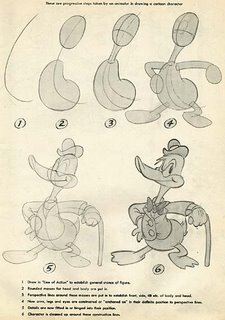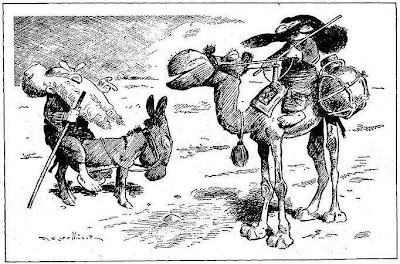 Every now and then I have to go back and remind people that the number 1 most important weapon in your cartoon arsenal is CONSTRUCTION.
Every now and then I have to go back and remind people that the number 1 most important weapon in your cartoon arsenal is CONSTRUCTION.Every other artistic principle, technique or tool is less important - and easier to learn once you can actually draw a solid figure.
People ask me to critique their lines of actions and negative spaces or their character designs, which is fine - but they still haven't learned to draw a 3 dimensional figure.
So here's this month's reminder to learn construction and a step by step guide how to construct something.
The best way for you to learn this is to do the drawings in the Preston Blair book
 http://johnkstuff.blogspot.com/2008/01/first-steps-for-ross-basic-construction.html
http://johnkstuff.blogspot.com/2008/01/first-steps-for-ross-basic-construction.htmland THEN to copy drawings by the best animators and cartoonists who do this well.
 Pinocchio and Captain Hook use the same fundamental skills. The main difference is in complexity. Hook has taller more difficult proportions, and more details to control. The details start to make sense the more you understand how they fit into larger forms.
Pinocchio and Captain Hook use the same fundamental skills. The main difference is in complexity. Hook has taller more difficult proportions, and more details to control. The details start to make sense the more you understand how they fit into larger forms.
http://johnkstuff.blogspot.com/2006/05/animation-school-lesson-1-construction.html
http://johnkstuff.blogspot.com/2006/05/animation-lesson-4-2-legged-characters.html
Don't try to learn fundamentals by designing your own character designs. You are putting the cart before the horse by trying to pose something that is full of design flaws. Copy someone who knows what they are doing and learn how they do it. Then later, when you are competent, you can apply what you learned to your own poses and drawings.
Harvey Eisenberg is one of the most technically able cartoonists and he is great to learn from, because his drawings are so carefully constructed. They follow all the classic principles, have great balance and no superfluous details.




 BY THE WAY!!!
BY THE WAY!!!If you do this exercise and copy drawings like these, don't trace them like I did. Copy them using the same step by step process. I just did it on the computer so I could separate each step on its own layer to show you. Tracing is cheating though.
I used to copy still frames from old cartoons off 8 mm cartoon prints. I took a bunch of my pencil sketches to Friz Freleng when he was looking for artists on "The Looney Looney Looney Bugs Bunny Movie". He took a look at them and said "What didya do, trace 'em?" I didn't but that was a good proof to me of the value of being very slow and careful in learning from the masters. He didn't hire me though, because he refused to believe I drew them -maybe because he couldn't draw his characters himself. "No young punks today can draw that stuff." I eventually did get to work for him on "The Pink Panther Zygotes" or something and he was a very crotchety and funny.
PART 2: I'll show you how to add the details in the next post.
---------------------------------------------------------------
Now you may think, "I don't want to draw in Harvey Eisenberg's style", "I want to be completely original, never go to the dentist or bathe, eschew toilet tissue and make cave paintings with sticks covered in ox-blood", or "I like Tom Oreb's more flat designy style."If you are a fan of Frank Thomas, Tom Oreb, Rod Scribner, Bob McKimson, Bobe Cannon, Tex Avery, John Hubley, Milt Kahl or any of a horde of great animators and designers from the Golden Age you can learn the tools and language they all share in common.












Every one of these artists uses the same basic principles of 40s constructed animation characters, yet they each developed very distinct and well-loved styles. They also share many tools with related fields - illustration, stage, movies, music and more. I talk about those all the time, but the #1 tool that makes us cartoonists unique is cartoon drawings. Simple drawings that are fun and unrealistic, yet are still good drawings.
It's not a good idea to try to learn fundamentals by copying a strong stylist like Tom Oreb or Jim Tyer - or Disney artists in the 50s, because it's harder to see the underlying principles and visual forces that hold the drawings together. After you understand and CAN DRAW the basic principles on your own, then you can study the variations of the stylists and add stylistic techniques to your own work.
If you are a fan of classic cartoons and you want to learn fast and get to the point where your own drawings have that much appeal and strength, then learn from the best and most controlled and conservative.
The kind of animation I promote on my blog is entertainment animation that requires a lot of people to work on the same cartoons. We all have to share the same language and grammar, or there's no way we can make a comprehensive community effort. Not every artist in a studio can just go his own way and make whatever mistakes he wants to make and call it his style. Each artist is subject to a director and a story, and needs the tools with which to make the story work. Or he won't be useful.
You can be an independent animator if you don't want to be part of a team, and that's fine. No rules and if you work real hard and learn to promote yourself as a rebel, a small but maybe dedicated audience will be your reward.

The better you can draw though, the more choices you will have.

